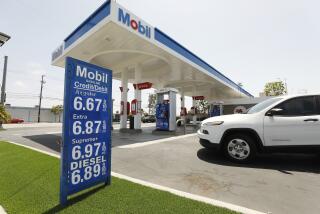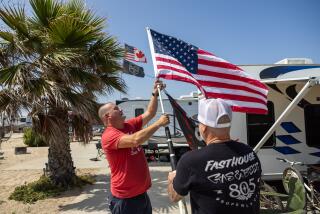EARTHWATCH : How to Sip Gas : With gasoline prices rising, a few simple steps can help you make a gallon of gas go farther.
- Share via
As of last Wednesday, driving our cars in California became a little bit more expensive. That was the day the additional 5-cent-a-gallon state gasoline tax was tacked on to help pay for road and bridge repair.
OK, fair enough, we have to keep the roads in good shape. But even at only 50 cents to a dollar more per fill-up, it is another 50 cents to a dollar we no longer have in our pockets. With gas prices going up anyway, and OPEC demanding the base price of a barrel of crude oil be raised, if we’re not careful, even a trip to the grocery store will become a pretty expensive proposition.
So, can anything be done about it? Are there practical ways to get a little better gas mileage out of Ol’ Betsy? Well, there’s good news and there’s bad news.
The good news is: Yes there are ways to squeeze more miles out of a gallon of gas. The bad news is: Some of them will cost us; things such as keeping the car perfectly tuned. But there are many free, and some inexpensive ways to cut gas consumption while making the environment a little less polluted.
One of the easiest ways to use less gasoline is to obey the 55-m.p.h. speed limit.
Now don’t moan and try to turn the page. Ninety-nine percent of the automobiles on the highways today use less gasoline at 55 m.p.h. than at 65 m.p.h. or 70 m.p.h. If you don’t believe me, ask any gas station mechanic or call your dealer. Not every trip has to be at warp speed.
Here are some more ideas:
* Don’t warm up the car too long in the morning. Read the instruction book that came with it and you’ll find the best way to start the car, and usually the recommended time to let it idle. Unless you live north of the Arctic Circle, letting your car sit for more than a few minutes is usually a waste of gasoline.
* Don’t roar off when the traffic light turns green. Rather, ease down on the gas pedal. That doesn’t mean you have to become a tortoise on the highway, but a gradual buildup of speed will use less gas than a rabbit-type start.
* Time the traffic lights. Try to adjust your speed in traffic so you hit the series of green lights. Many main streets and boulevards have their signals set so if you drive at the posted speed limit or just below it, you’ll putt right through. By not starting and stopping, you save gas, not to mention wear and tear on the engine.
* Keep the tires properly inflated. One of the biggest causes of declining gas mileage is tires with too little air in them. When there is less air than the manufacturer recommends, more power is needed to not only to get the car moving but to keep it moving. Under-inflation also causes increased tire wear. Somewhere on the outside of the tire is the recommended inflation pressure. But try not to exceed it. Too much air will cause a harder ride and may mean poorer control.
Buy a tire gauge and keep it in the glove compartment. While most gas stations still have air pumps, many have defective gauges on them.
* Buy radial tires. Radial tires need less gas to do their job than regular bias-ply tires. If you have good bias plys on now, leave them, there’s no sense in throwing away good money. But the next time you’re going to get new tires, consider radials. Depending on the brand, they can be anywhere from a little to a lot more expensive.
* Change the air filter every three months or 3,500 miles. If you can’t remember when you changed it last, it’s probably time to do so.
Where is it? It’s sitting on top of the engine in a large, round canister resembling the flight deck of the Starship Enterprise, with a wing nut in the middle. Remove the wing nut--put it in your pocket so you know where it is--and any clamps holding down the lid. Pull out the round air cleaner inside.
There are two simple ways to determine if it’s clean or not. If the serrated paper edge is black and grimy and there’s a sticker on it that says, “Installed, Aug. 1, 1954,” you have your answer.
But if it’s white or light gray, it still may be good. Take it out, hold it up and see if you can see sunlight through the paper. If you can, leave it. If not, knock it on the inside of a trash can to see if you can get some of the dust out. Better yet, take the air filter to a nearby auto parts store. Tell them the make, model, and if you know it, the engine size of your car (check your car handbook). Put in the new one, zip down the wing nut and/or reattach the clamps, and you’re off.
* Don’t use the air conditioner when you don’t have to. Sure it’s hot. But if you’re making a quick trip to the market two blocks away, roll down the window instead. First, you save wear and tear on your cold engine, and second, without the air conditioner running, you get better gas mileage.
The best time to run the air conditioner is on the freeway, doing at least 50 m.p.h. At that speed, there’s sufficient airflow to keep the engine cool, and gas consumption will not be as drastic as when doing stop-and-go driving with the air conditioner on.
Now, if you can’t do all of these steps, maybe you can do some of them. And if everybody else does some, that means we have better gas mileage, less smog and cleaner air.
More to Read
Sign up for Essential California
The most important California stories and recommendations in your inbox every morning.
You may occasionally receive promotional content from the Los Angeles Times.













